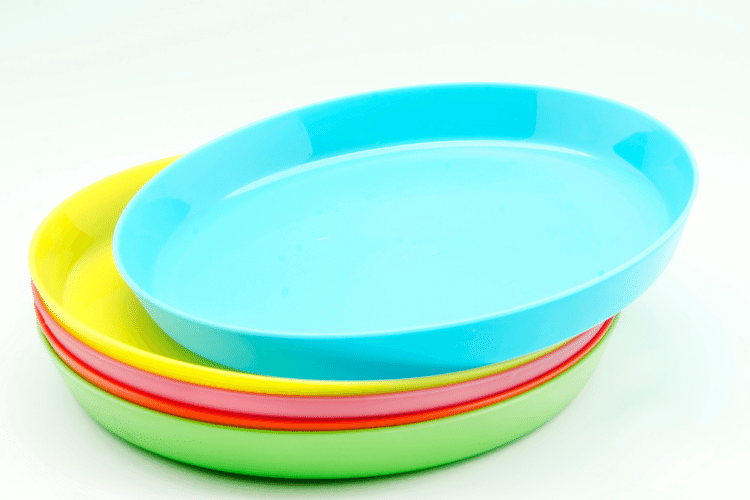Wheat straw plates are plates made from the stalks of wheat plants after the grains have been harvested. Plastic plates, on the other hand, are made from petroleum-based plastic materials.
The Purpose of the comparison is to evaluate the advantages and disadvantages of wheat straw and plastic plates and determine which is better for various purposes, such as food service and the environment.
Some key differences between wheat straw and plastic plates include their composition, environmental impact, durability, cost, and versatility.
Advantages of Wheat Straw Plates
There are many advantages of Wheat straw plates.
A few advantages are listed below:
Environmentally Friendly: Wheat straw plates are environmentally friendly because they are made from a renewable resource and are biodegradable, meaning they will decompose over time and do not contribute to plastic waste.
Biodegradable: Unlike plastic plates, wheat straw plates are biodegradable and will decompose naturally, reducing their impact on the environment.
Renewable Resource: Wheat straw is a renewable resource that can be grown every year, making it a sustainable alternative to plastic plates.
Safe For Food Use: Wheat straw plates do not contain harmful chemicals that can leach into food, making them a safe choice for food service.
Durable and Long-Lasting: Wheat straw plates are known to be durable and long lasting, making them an ideal choice for events or everyday use.

Disadvantages of Wheat Straw Plates
There are many disadvantages to Wheat Straw Plates, as listed below :
More Expensive Than Plastic: While wheat straw plates are a more eco-friendly alternative to plastic, they are usually more costly, making them a less accessible choice for some people.
Limited availability in stores: Wheat straw plates may only be widely available in some stores, making them harder to find and purchase.
May become brittle over time: Wheat straw plates may become brittle and break more easily compared to plastic plates.
May become discolored after extended use: Over time, wheat straw plates may become discolored, especially after extended use or exposure to liquids or moisture.
Advantages of Plastic Plates
There are many advantages of Plastic plates, as listed below :
Affordable: Plastic plates are usually more affordable compared to wheat straw plates, making them a more economical choice for many people.
Lightweight and Easy To Carry: Plastic plates are light, making them easy to carry and transport, especially for outdoor events or picnics.
Available in Various Colors and Designs: Plastic plates come in multiple colors and designs, making them a versatile choice for any occasion.
Easy To Clean and Maintain: Plastic plates are easy to clean and maintain, making them a convenient choice for everyday use.
Microwave Safe: Plastic plates are microwave safe, making them a practical choice for heating food or leftovers.
Disadvantages of Plastic Plates
Some disadvantages of plastic plates are as listed below :
Harmful to the Environment: Plastic plates are harmful to the environment as they are non-biodegradable and take hundreds of years to break down, leading to plastic pollution and waste.
Non-biodegradable: Plastic plates do not decompose, leading to long-term environmental and wildlife harm.
Petroleum-based, non-renewable resource: Plastic plates are made from petroleum, a non-renewable resource that contributes to the depletion of natural resources.
Leaches toxic chemicals into food: Plastic plates can leach toxic chemicals into food, especially when heated or exposed to acidic or high-temperature substances, making them a potentially dangerous choice for food service.
Advantages and Disadvantages of Wheat Straw Plates vs. Plastic Plates
The table that shows the advantages and disadvantages of wheat straw and plastic at a glance :
| Features | Wheat Straw Plates | Plastic Plates |
|---|---|---|
| Environmentally friendly | Yes | No |
| Biodegradable | Yes | No |
| Renewable resource | Yes | No |
| Safe for food use | Yes | No |
| Durable and long-lasting | Yes | No |
| Affordable | No | Yes |
| Lightweight and easy to carry | No | Yes |
| Available in a variety of colors and designs | No | Yes |
| Easy to clean and maintain | No | Yes |
| Microwave safe | No | Yes |
Note: The table shows that both wheat straw plates and plastic plates have advantages and disadvantages, and the best choice depends on individual needs and priorities.
Summary of key differences and similarities
Wheat straws and plastic plates have advantages and disadvantages, and the best choice depends on individual needs and priorities.
Wheat straw plates are environmentally friendly, biodegradable, and safe for food use, but they are more expensive and may become brittle over time.
Plastic plates are affordable, lightweight, and easy to clean, but harmful to the environment, non-biodegradable, and can leach toxic chemicals into food.
The best plate to choose depends on individual needs and priorities, such as budget, convenience, and environmental impact.
If eco-friendliness and food safety are top priorities, wheat straw plates may be the better choice. Plastic plates may be a better option if affordability and convenience are more important.
Final Thoughts
Choosing eco-friendly products, such as wheat straw plates, reduces waste and minimizes environmental harm.
Every small action counts, and switching to more sustainable products can help create a more sustainable future.
